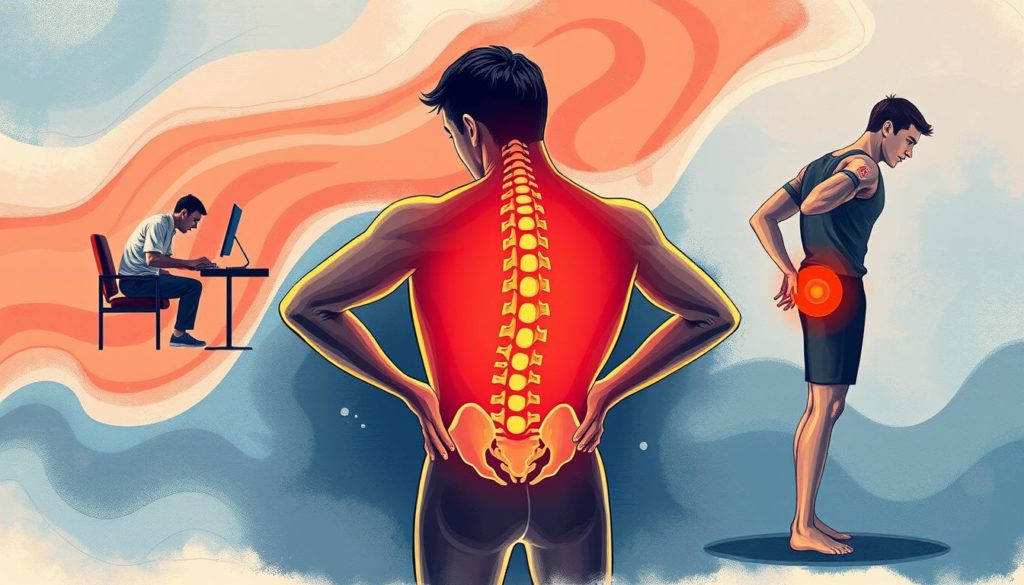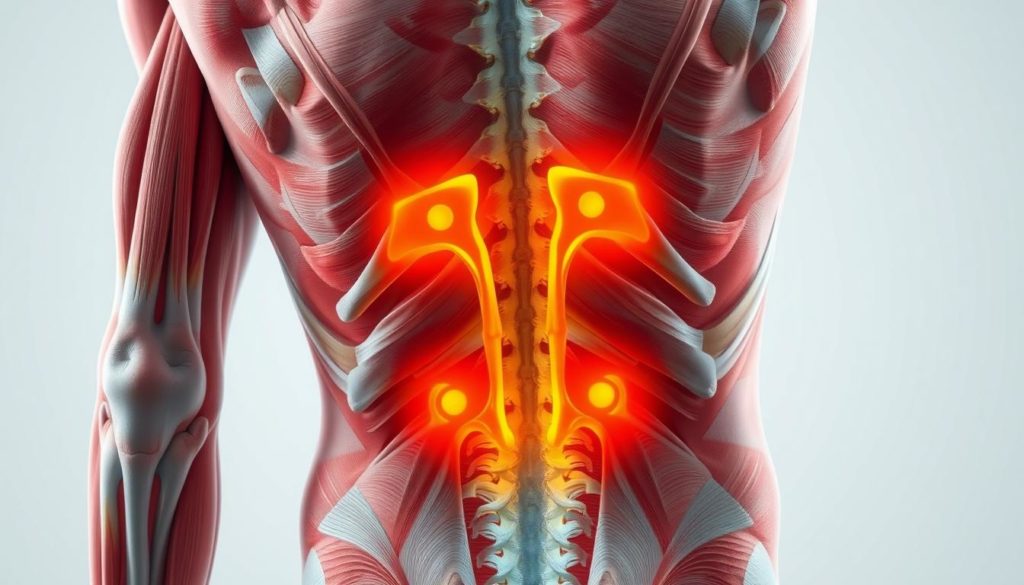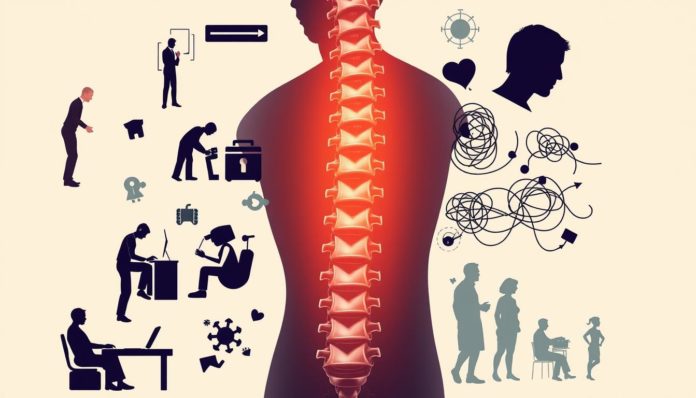Did you know almost 80% of Americans deal with back pain at some point? This fact highlights how common back pain really is.
The Mayo Clinic points out many factors can lead to back pain. These can be muscle or ligament strain from lifting wrong or bad posture. Other causes are being overweight or not exercising enough. Moreover, serious issues like spinal fractures, disk problems, arthritis, and infections play a role. Knowing the causes of lower back pain helps in diagnosing and treating it effectively.
Also, some diseases like ankylosing spondylitis, fibromyalgia, and endometriosis often cause chronic back pain. Realizing the full scope of possible causes is key to finding relief.
Introduction to Back Pain
Back pain affects millions around the world. It comes from muscle, ligament, tendon, disk, and bone issues. It can start suddenly or grow slowly due to bad posture, repeating the same movements, and not lifting properly.

What is Back Pain?
Back pain means discomfort in the back’s spine or muscles. It can be a mild ache or very sharp. The spine, with its 24 vertebrae, makes our body stable and flexible.
Problems in any part of the back can cause pain.
Prevalence of Back Pain
About 80% of adults will feel back pain at some point. Muscle strains, ligament sprains, disk wear, and spine shape issues are common causes. Knowing why back pain starts helps in finding treatments.
Realizing back pain comes from many sources underlines the need for well-rounded care.
Muscle and Ligament Strains
One of the main reasons for back pain is muscle and ligament strains. These often hit the lower back and neck area. They come from overdoing it, sudden moves, or not lifting correctly. This can lead to a lot of discomfort.

Causes of Strains
Many things can cause muscle strains and injuries to ligaments. Here are some common reasons:
- Pushing too hard during physical activities
- Lifting heavy stuff the wrong way
- Quick movements or slips and falls
Symptoms of Strains
Symptoms of muscle and ligament strains mostly show up in key spine support areas. You might notice:
- Pain in one spot
- Uncontrolled muscle contractions
- Getting puffy and swollen
Treatment for Strains
There are many ways to look after muscle and ligament injuries. To start, you might use:
- Medicine from the store for pain
- Applying cold and warm packs
- Soft movements and stretches
If it’s really bad, you might need more help. This could be seeing a physical therapist, a chiropractor, or trying acupuncture. It’s all about getting better.
Spinal Fractures and Ruptured Disks
Back pain is often linked to severe injuries like spinal fractures and ruptured disks. These issues are known causes of chronic back pain. Knowing about their signs and treatment options is key for those suffering from severe back pain.
Understanding Spinal Fractures
Spinal fractures can result from high-impact activities. These include contact sports, car crashes, and falls. Such fractures cause terrible back pain and can harm the spine’s structure. Getting medical help right away is vital to avoid more problems from untreated fractures.
Ruptured Disks: What Are They?
Ruptured disks, or herniated disks, occur when a disk’s soft center breaks through its outer layer. This often leads to intense pain and weakness. The escaping disk material can squeeze nearby nerves. The pain from ruptured disks can seriously affect everyday life and movement.
Treatment Options for Serious Injuries
Treating injuries like spinal fractures and ruptured disks usually requires painkillers, physical therapy, and maybe surgery. The specific treatment depends on how bad the injury is and the person’s health. These are some common methods:
- Pain Medication: Often the first line of treatment to manage immediate pain.
- Physical Therapy: Helps in strengthening the muscles around the spine to provide better support.
- Surgery: Considered when conservative treatments fail to alleviate the condition.
Consulting healthcare experts is crucial for treating spinal fractures or ruptured disks. Early treatment can greatly help recovery.
Arthritis and Age-Related Spine Changes
As we age, our spine’s health can decline due to arthritis and wear and tear. This can lead to significant back pain. Knowing about arthritis and spinal decline is key for taking care of our backs.
How Arthritis Affects Your Back
Arthritis, mainly osteoarthritis, wears down the cartilage in the vertebrae. This can create bone spurs, causing pain and discomfort. It’s important to focus on these symptoms since they can lead to severe back pain.
Age-Related Spinal Degeneration
Spinal changes happen as we age, similar to arthritis effects. Cartilage loss and herniated disks can occur, making movement painful. These changes often cause back pain in older adults.
Managing Arthritic Back Pain
Management includes medications, exercise, and massage for arthritis-induced back pain. Staying active helps slow spinal decline, easing common back pain from aging.
| Condition | Common Triggers | Management Strategies |
|---|---|---|
| Arthritis | Bone spurs, cartilage wear | Medication, exercise, massage |
| Spinal Degeneration | Herniated disks, cartilage loss | Active lifestyle, physical therapy |
Infections That Cause Back Pain
Having back pain caused by infections is a serious health concern. It interrupts everyday activities. Knowing what infections lead to this pain is key to getting the right treatment fast.
Types of Infections
Different infections can cause back pain. Here are a few common ones:
- Kidney Infections: These often feel like severe lower back pain.
- Osteomyelitis: This is a bone infection causing a lot of pain.
- Abdominal Aortic Aneurysm: Not a back infection, but its pain can spread to the spine.
Symptoms of Spine Infections
Seeing the early signs of spine infections helps get help sooner. Some usual symptoms are:
- Back pain that doesn’t go away.
- Fever and chills.
- Feeling tired and losing weight.
- Area feels warm or looks red.
Diagnosis and Treatment
To find out if you have a spine infection, doctors might use imaging tests and lab work. Here are common ways to diagnose:
| Diagnostic Method | Purpose |
|---|---|
| MRI/CT Scans | To get a clear view of the problem area. |
| Blood Tests | To look for infection or inflammation markers. |
| Biopsy | To check tissue samples for infectious germs. |
The treatment for spine infections depends on how severe it is and the infection type. Common treatments include:
- Antibiotics: Used first for bacterial infections.
- Surgery: Needed in serious cases to remove the infection.
- Supportive Care: Includes pain relief and physical therapy for better recovery.
Other Medical Conditions Triggering Back Pain
Some medical conditions causing back pain are not widely known. Knowing about these can help manage and treat them better.
Ankylosing Spondylitis
Ankylosing spondylitis mainly targets the spine. It causes inflammation in spinal joints leading to pain and stiffness. Eventually, it might even make the spine bones fuse, limiting movement a lot.
Fibromyalgia
Fibromyalgia involves pain all over the body, including the back. People with it have tender spots, feel very tired, and might not sleep well. These issues make back pain worse.
Endometriosis
Endometriosis happens when tissue like the uterus lining grows outside it. This tissue can attach to pelvic organs and back nerves, causing a lot of pain. Even though it’s often linked with pelvic pain, it can also cause severe back pain.
Common Causes of Back Pain
Understanding back pain causes is key to preventing and treating it. Common reasons include muscle sprains and strains from overuse or injury. Another major cause is disk degeneration. This happens when the spine’s cushioning disks wear down over time, causing pain and limiting movement.
Arthritis is also a major cause of back pain. Osteoarthritis, for instance, can make the spine stiff and inflamed. Also, skeletal issues like scoliosis, which means the spine curves oddly, can lead to ongoing back pain.
Osteoporosis makes bones weak and can lead to back pain by making the spine more prone to fractures. Everyday actions and habits are also important. Things like heavy lifting, poor posture for too long, and not exercising enough can hurt the spine and muscles.
To summarize the common back pain causes and their effects:
| Cause | Description | Effects |
|---|---|---|
| Muscle Sprain and Strain | Overuse or sudden injury to muscles | Pain, stiffness, limited movement |
| Disk Degeneration | Deterioration of cushioning disks | Chronic pain, restricted movement |
| Arthritis | Inflammation and stiffness in joints | Persistent discomfort, limited mobility |
| Skeletal Irregularities | Abnormal spine curvatures like scoliosis | Chronic pain, posture issues |
| Osteoporosis | Weakening of bones | Increased fracture risk, chronic pain |
| Daily Habits | Poor posture, heavy lifting, inactivity | Acute or chronic pain, muscle strain |
By understanding these back pain reasons, people can change their habits and get the right medical help. This way, they can better manage and prevent back pain.
Factors Increasing Risk of Back Pain
Learning what increases back pain risk helps in prevention. We’ll look at obesity, smoking, and job risks, including stress from work.
Obesity and Back Pain
Obesity majorly ups back pain risk. Extra weight strains the spine and its muscles. This strain can cause muscle issues, disk problems, and spine misalignment.
Smoking and Back Pain Risk
Smoking also raises back pain risk. Studies show it cuts blood flow, starving spinal tissues of nutrients and oxygen. This worsens spinal health over time, making smokers prone to back issues.
Occupational Hazards
Job stress, heavy lifting, and long sitting spell trouble for your back. Stress cramps muscles, causing pain. Jobs demanding constant physical work or sitting can hurt the spine over time.
- Obesity: Increases spine pressure
- Smoking: Reduces blood flow
- Work-related stress: Tightens muscles
Pregnancy and Back Pain
Having a baby is a wonderful journey, but it comes with its challenges. One common challenge is back pain caused by pregnancy. This happens because of hormonal changes and the extra weight moms-to-be carry.
Causes During Pregnancy
Back pain during pregnancy happens for several reasons:
- Hormonal Changes: The hormone relaxin makes your pelvic ligaments loose. This can make your spine less stable.
- Weight Gain: Gaining extra weight puts more stress on your back.
- Posture Shifts: As your baby grows, your body’s balance changes. This can strain your back.
Managing Back Pain in Pregnancy
There are ways to manage back pain when you’re pregnant:
- Maintain Good Posture: Try to stand up straight and keep your shoulders back.
- Regular Exercise: Do safe exercises like walking or swimming. They help strengthen your back.
- Supported Sleeping Positions: Sleep on your side and put a pillow between your legs. It helps keep your spine aligned.
- Consult Healthcare Professionals: Talk to your doctor or a prenatal chiropractor. They can offer safe ways to reduce pain.
| Factors | Impacts |
|---|---|
| Hormonal Changes | Loosens ligaments, destabilizing the spine |
| Weight Gain | Increases strain on back muscles |
| Posture Shifts | Shifts center of gravity, causing strain |
Nerve-related Back Pain
Nerve-related back pain can really slow someone down. It comes from issues like sciatica, spinal stenosis, and herniated disks. Knowing about these problems helps manage and treat them better.
Sciatica
Sciatica is a well-known type of nerve-related back pain. It happens when the sciatic nerve gets pinched or irritated. This causes pain to spread from the lower back into the leg. People with sciatica often feel sharp pain, numbness, and tingling in their leg. To treat it, options include physical therapy, medicine, and sometimes surgery.
Spinal Stenosis
Spinal stenosis means the spinal canal has gotten too narrow. This puts pressure on the spinal cord and nerves. It causes nerve-related back pain, weakness, and balance or walking problems. Treatments start with exercise and medicine. Some severe cases might need surgery to make more space in the spinal canal.
Herniated Disks
Herniated disks happen when a disk’s soft center pushes through its tough outer layer. This puts pressure on the nearby nerves, leading to nerve-related back pain. Signs include pain, weakness, and a lack of feeling along the nerve. Treatments often combine physical therapy, anti-inflammatory medicine, and possibly surgery.
Poor Posture and Its Effects
Good posture is key for staying healthy. Yet, many overlook it. This can lead to health problems. Learning about these issues and how to solve them is important. It helps keep you free from pain.
Impact of Long-term Poor Posture
Keeping bad posture for too long can create imbalance. This means more tension in muscles and spine stress. It often results in back pain that sticks around. Paying attention to your posture and fixing it regularly can help.
Correcting Your Posture
To fix your posture, you need to spot and change bad habits. Little things, like keeping your shoulders back and spine straight, matter a lot. Being active in this way lessens muscle and joint strain.
Exercises for Better Posture
Exercise plays a big role in better posture. Activities like yoga or Pilates strengthen muscles and improve flexibility. They’re key in fixing and keeping good posture. Keeping up with these exercises ensures your body stays aligned and stress-free.
Psychological and Emotional Factors
Understanding how our mind affects back pain is key. Our thoughts and feelings can influence our physical health. This often starts a cycle of pain and stress.
Stress and Back Pain
Stress and back pain are closely linked. Stress can make muscles tense up and spasm. This causes ongoing back pain. Managing stress through mindfulness and yoga can help ease this pain.
Anxiety and Pain Perception
Anxiety can make pain seem worse than it is. It makes the feeling of pain stronger, affecting daily activities. Using techniques like cognitive-behavioral therapy can reduce anxiety and how we perceive pain.
Impact of Mental Health on Back Pain
Mental health greatly affects back pain. Depression and ongoing stress lead to tense muscles and more pain. Getting regular mental health check-ups and counseling helps manage mental and physical health. This improves life quality.
- Mindfulness practices: This can cut down on stress.
- Counseling: This deals with emotional issues that cause pain.
- Exercise: Being active releases endorphins that fight stress and anxiety.
Addressing psychological factors in back pain is crucial for overall health. Understanding and tackling stress and back pain, and knowing the mental health impact, can make a big difference in well-being.
Preventive Measures and Lifestyle Changes
Preventing back pain begins with choosing a healthy lifestyle. Keep a healthy weight to ease spine strain. Regular exercises that make core muscles stronger help a lot.
Swimming, walking, or yoga can be great for keeping the back in good shape. These activities keep the back strong and flexible.
To take care of your back, change some everyday habits. Always use your knees, not your back, when lifting. This avoids extra strain. Also, keep your spine straight when you sit and stand. Choosing a medium-firm mattress supports your spine during sleep.
Don’t forget the role of stress management in back health. Stress can make muscles tight and increase back pain. Mindfulness and deep breathing can help. Stopping smoking is also key. It helps blood flow to the spine better.
Making these changes can greatly reduce back pain risks. It makes your back healthier overall.
FAQ
What causes back pain?
Back pain stems from various sources like muscle or ligament damage due to heavy lifting or bad posture. Other causes include being overweight, not exercising, spinal fractures, disc problems, and certain diseases. Conditions like fibromyalgia and endometriosis also play a part. Repetitive motions or sitting too long without the right support can also lead to back pain.
How common is back pain?
Back pain is very common. It’s a leading reason for missing work or seeing a doctor. At some point, nearly everyone will deal with back pain.
What are the common symptoms of back muscle and ligament strains?
Symptoms include pain, muscle spasms, and stiffness in the back. The pain often stays in one area and gets worse with movement.
What are spinal fractures and ruptured disks?
Spinal fractures are bone breaks in the spine caused by accidents or falls. Ruptured disks, or herniated disks, happen when a disk’s inner material bulges out. This can press on nerves and lead to pain or weakness.
How does arthritis impact the spine?
Arthritis, mainly osteoarthritis, wears down spine cartilage. This can lead to painful bone spurs or disk issues. Aging also causes similar spine problems.
Can infections cause back pain?
Yes, infections like those in the kidney or osteomyelitis can trigger back pain. This pain is often intense and may come with a fever.
What medical conditions can cause back pain?
Conditions such as ankylosing spondylitis, fibromyalgia, and endometriosis can cause back pain, among other symptoms.
What lifestyle factors increase the risk of back pain?
Being overweight, smoking, and jobs that involve heavy lifting or lots of sitting can raise back pain risk. Mental health issues like anxiety or depression can make it worse.
Why does pregnancy cause back pain?
Pregnancy leads to back pain due to hormonal changes, extra weight stress, and posture changes as the belly grows.
What are the causes of nerve-related back pain?
Nerve pain in the back can happen with sciatica, spinal stenosis, or herniated disks. These often cause pain that spreads, numbness, or weakness.
How does poor posture affect back pain?
Bad posture causes uneven weight distribution, leading to muscle tension and back pain. Long-lasting posture issues might need exercises or ergonomic solutions.
Can stress and anxiety contribute to back pain?
Indeed, stress and anxiety can raise muscle tension and pain perception, making back pain worse or creating it.
What are some preventive measures to avoid back pain?
To prevent back pain, keep a healthy weight, don’t smoke, lift correctly, stay active, and ensure good posture. Sleeping on a supportive mattress and doing core muscle exercises help too.


